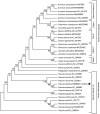Molecular structure and phylogenetic analysis of complete chloroplast genomes of medicinal species Paeonia lactiflora from Zhejiang Province
- PMID: 33366882
- PMCID: PMC7748428
- DOI: 10.1080/23802359.2020.1721372
Molecular structure and phylogenetic analysis of complete chloroplast genomes of medicinal species Paeonia lactiflora from Zhejiang Province
Abstract
Paeonia lactiflora is a geo-authentic and superior medicinal plant in Zhejiang province. Here, we report the complete chloroplast genome sequence of P. lactiflora. The total genome size of P. lactiflora is 153,405 bp in length, including a small single-copy (SSC) region of 16,969 bp, a large single-copy (LSC) region of 84,340 bp separated by a pair of inverted repeats (IRs) of 26,048 bp. The overall annotated gene number is 109, containing 76 protein-coding genes, 29 tRNAs and 4 rRNAs. The entire GC content of P. lactiflora is 38.43%, with the highest GC content of 42.99% in IR region. A total of 52 simple sequence repeats are identified in the cp genome of P. lactiflora. Phylogenetic analysis indicated a sister relationship between P. lactiflora and P. veitchii, and supported a unique evolutionary status of Family Paeoniaceae. This work provides a valuable genetic resource to develop robust markers and investigate the population genetics diversities for this famous medicinal species.
Keywords: Paeonia lactiflora; chloroplast genome; phylogenetic analysis; simple sequence repeats.
© 2020 The Author(s). Published by Informa UK Limited, trading as Taylor & Francis Group.
Conflict of interest statement
No potential conflict of interest was reported by the authors.
Figures

Similar articles
-
The Complete Mitochondrial Genome of Paeonia lactiflora Pall. (Saxifragales: Paeoniaceae): Evidence of Gene Transfer from Chloroplast to Mitochondrial Genome.Genes (Basel). 2024 Feb 14;15(2):239. doi: 10.3390/genes15020239. Genes (Basel). 2024. PMID: 38397228 Free PMC article.
-
Complete chloroplast genome of Stephania tetrandra (Menispermaceae) from Zhejiang Province: insights into molecular structures, comparative genome analysis, mutational hotspots and phylogenetic relationships.BMC Genomics. 2021 Dec 6;22(1):880. doi: 10.1186/s12864-021-08193-x. BMC Genomics. 2021. PMID: 34872502 Free PMC article.
-
The complete chloroplast genome of Paeonia lactiflora Pall. (Paeoniaceae).Mitochondrial DNA B Resour. 2019 Jul 22;4(2):2715-2716. doi: 10.1080/23802359.2019.1644548. Mitochondrial DNA B Resour. 2019. PMID: 33365696 Free PMC article.
-
The complete chloroplast genome sequence of the medicinal plant Paeonia delavayi Franchet. (Paeoniaceae).Mitochondrial DNA B Resour. 2019 Oct 15;4(2):3553-3555. doi: 10.1080/23802359.2019.1677528. Mitochondrial DNA B Resour. 2019. PMID: 33366082 Free PMC article.
-
Characterization of the complete chloroplast genome of Oxalis corymbosa DC. (Oxalidaceae), a medicinal plant from Zhejiang Province.Mitochondrial DNA B Resour. 2021 Mar 22;6(3):1138-1140. doi: 10.1080/23802359.2021.1882905. Mitochondrial DNA B Resour. 2021. PMID: 33796768 Free PMC article.
Cited by
-
Characterization of the complete chloroplast genome of the medicinal plant Orixa japonica (Rutaceae) in Zhejiang Province and its phylogenetic analysis within family Rutaceae.Mitochondrial DNA B Resour. 2021 May 24;6(6):1734-1736. doi: 10.1080/23802359.2021.1931511. Mitochondrial DNA B Resour. 2021. PMID: 34104754 Free PMC article.
-
The Complete Mitochondrial Genome of Paeonia lactiflora Pall. (Saxifragales: Paeoniaceae): Evidence of Gene Transfer from Chloroplast to Mitochondrial Genome.Genes (Basel). 2024 Feb 14;15(2):239. doi: 10.3390/genes15020239. Genes (Basel). 2024. PMID: 38397228 Free PMC article.
-
Development of Mini-Barcode Based on Chloroplast Genome and Its Application in Metabarcoding Molecular Identification of Chinese Medicinal Material Radix Paeoniae Rubra (Chishao).Front Plant Sci. 2022 Mar 31;13:819822. doi: 10.3389/fpls.2022.819822. eCollection 2022. Front Plant Sci. 2022. PMID: 35432422 Free PMC article.
-
Complete chloroplast genome of Stephania tetrandra (Menispermaceae) from Zhejiang Province: insights into molecular structures, comparative genome analysis, mutational hotspots and phylogenetic relationships.BMC Genomics. 2021 Dec 6;22(1):880. doi: 10.1186/s12864-021-08193-x. BMC Genomics. 2021. PMID: 34872502 Free PMC article.
-
Complete chloroplast genome sequence of the medicinal plant ramie (Boehmeria nivea L. gaud) and its phylogenetic relationship to other Urticaceae species.Mitochondrial DNA B Resour. 2021 Mar 22;6(3):1136-1137. doi: 10.1080/23802359.2021.1878959. Mitochondrial DNA B Resour. 2021. PMID: 33796767 Free PMC article.
References
-
- Guo XF. 2002. Advances in classification of Chinese herbaceous peony. J Beijing Univ. 24:99–102.
-
- Liu P, Xu YF, Gao XD, Zhu XY, Du MZ, Wang YX, Deng RX, Gao JY. 2017. Optimization of ultrasonic-assisted extraction of oil from the seed kernelsand isolation of monoterpene glycosides from the oil residue of Paeonia lactiflora Pall. Ind Crop Prod. 107:260–270.
LinkOut - more resources
Full Text Sources
Miscellaneous
